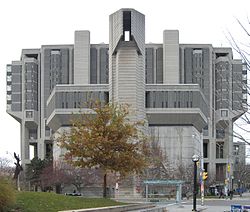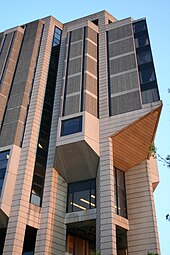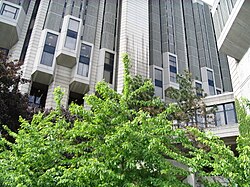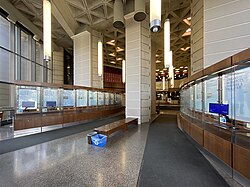
Victoria University is a federated university, which forms part of the wider University of Toronto. The school was founded in 1836 by the Wesleyan Methodist Church of Canada as a nonsectarian literary institution. From 1841 to 1890, Victoria operated as an independent degree-granting university, before federating with the University of Toronto in 1890, relocating from Cobourg to Toronto.

The University of Toronto Scarborough, also known as U of T Scarborough or UTSC, is one of the three campuses that make up the tri-campus system of the University of Toronto. Located in the Scarborough district, Toronto, Ontario, Canada, the campus is set upon suburban parkland next to Highland Creek. It was established in 1964 as Scarborough College, a constituent college of the Faculty of Arts and Science. The college expanded following its designation as an autonomic division of the university in 1972 and gradually became an independent institution. It ranks last in enrolment size among the three University of Toronto campuses, the other two being the St. George campus in Downtown Toronto and the University of Toronto Mississauga.
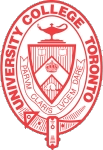
University College, popularly referred to as UC, is a constituent college of the University of Toronto, created in 1853 specifically as an institution of higher learning free of religious affiliation. It was the founding member of the university's modern collegiate system, and its non-denominationalism contrasted with contemporary colleges at the time, such as Trinity College and St. Michael's College, both of which later became part of the University of Toronto.

Woodsworth College, named after politician and clergyman James Shaver Woodsworth (1874–1942), is a constituent college of the University of Toronto in Canada. It is one of the largest colleges in the Faculty of Arts and Science at the St. George Campus. It is also the newest of the colleges at the University of Toronto, created in 1974. Woodsworth College's arms and badge were registered with the Canadian Heraldic Authority on October 15, 2006.
Brutalist architecture is an architectural style that emerged during the 1950s in the United Kingdom, among the reconstruction projects of the post-war era, but commonly known for its presence in post-war communist nations. Brutalist buildings are characterised by minimalist constructions that showcase the bare building materials and structural elements over decorative design. The style commonly makes use of exposed, unpainted concrete or brick, angular geometric shapes and a predominantly monochrome colour palette; other materials, such as steel, timber, and glass, are also featured.

The Joseph Regenstein Library, often referred to by students as "The Reg", is the main library of the University of Chicago, named after the industrialist and philanthropist Joseph Regenstein. It is one of the largest repositories of books in the world and is noted for its brutalist architecture.

The Toronto City Hall, or New City Hall, is the seat of the municipal government of Toronto, Ontario, Canada, and one of the city's most distinctive landmarks. Designed by Viljo Revell and engineered by Hannskarl Bandel, the building opened in 1965. The building is located adjacent to Nathan Phillips Square, a public square at the northwest intersection of Bay Street and Queen Street, that was designed and officially opened alongside Toronto City Hall.

Hong Kong City Hall is a building located at Edinburgh Place, Central, Hong Kong Island, Hong Kong.

1 Spadina Crescent, also known as the Daniels Building, is an academic building that houses the John H. Daniels Faculty of Architecture, Landscape, and Design at the University of Toronto in Toronto, Ontario, Canada. The building is situated in the centre of a roundabout of Spadina Avenue, north of College Street. Its location provides a picturesque vista looking north up Spadina Avenue; it is an axial view terminus for Spadina Avenue.

The University of Toronto Mississauga (UTM), also known as U of T Mississauga, is one of the three campuses that make up the tri-campus system of the University of Toronto. Located in Mississauga, Ontario, Canada, the campus opened in 1967 as Erindale College, set upon the valley of the Credit River, approximately 33 km west of Downtown Toronto. It is the second-largest of the three University of Toronto campuses, the other two of which are the St. George campus in Downtown Toronto and the U of T Scarborough campus in Scarborough, Ontario.
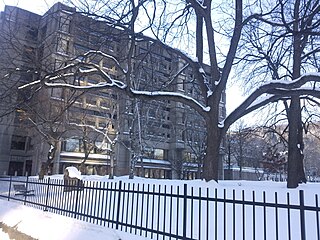
The McLennan Library Building is a major library building of McGill University in Montreal, Quebec, Canada. It is located at 3459 rue McTavish, at the northeast corner of rue Sherbrooke and McTavish. The building, along with the adjacent Redpath Library Building, currently houses the Humanities and Social Sciences Library, the largest branch of the McGill University Library.
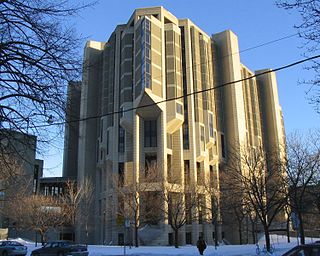
The University of Toronto Libraries system is the largest academic library in Canada and is ranked third among peer institutions in North America, behind only Harvard and Yale. The system consists of 39 libraries located on University of Toronto's three university campuses: St. George, Mississauga and Scarborough. This array of college libraries, special collections, and specialized libraries and information centres supports the teaching and research requirements of 215 graduate programs, over 60 professional programs, and more than 700 undergraduate degree programs. In addition to more than 12 million print volumes in 341 languages, the library system currently provides access to 150,467 journal titles, millions of electronic resources in various forms and almost 30,000 linear metres of archival material. More than 150,000 new print volumes are acquired each year.
George Edward Bemi was a Canadian architect who practiced in Ottawa, Ontario, from 1955 to 2005. During his prolific career, he contributed over 300 buildings to the National Capital area, including significant projects such as St. Basil's Church, the Main Branch of the Ottawa Public Library, the downtown YM-YWCA, and the Ottawa Police Headquarters. His buildings are primarily designed in a Modernist or Brutalist style of architecture, characterized by massive concrete forms, asymmetrical volumes, curtain wall, honest materiality, and a play between solids and voids.

The University of Toronto Mississauga is a satellite campus of the University of Toronto. It is in Mississauga, Ontario, Canada about 33 kilometres west of the main St. George campus. It was formerly called the Erindale College but was later changed to the University of Toronto Mississauga (UTM). The campus has eight main educational buildings: the Maanjiwe nendamowinan Building, Deerfield Hall, the William G. Davis Building, the Kaneff Centre and Blackwood Gallery, the Recreation, Athletic, and Wellness Centre, the Hazel McCallion Academic Learning Centre which holds UTM's library, the Instructional Building, and the new Terrence Donnelly Health Sciences Complex for the Mississauga Academy of Medicine. The campus also houses 3 residence halls: Erindale Hall, Roy Ivor Hall, and Oscar Peterson Hall.

The Charles E. Odegaard Undergraduate Library(OUGL) is a library on the campus of the University of Washington in Seattle, Washington. It houses secondary stacks, a learning commons and on-campus technology resources for students, primarily undergraduates. Named after the 19th president of the university, it opened in 1972, replacing the small undergraduate library previously located at Suzzallo Library. It fronts the northwest corner of Red Square and provides access to the parking garage below the plaza, which was built simultaneously with the library. In addition to library space, the building includes a cafeteria and newsstand on the ground floor.

The Ohio History Center is a history museum and research center in Columbus, Ohio. It is the primary museum for Ohio's history, and is the headquarters, offices, and library of the Ohio History Connection. The building also houses Ohio's state archives, also managed by the Ohio History Connection. The museum is located at the Ohio State Fairgrounds, site of the Ohio State Fair, and a short distance north of downtown. The history center opened in 1970 as the Ohio Historical Center, moving the museum from its former site by the Ohio State University. The building was designed by Ireland & Associates in the Brutalist style. It was listed on the National Register of Historic Places along with the Ohio Village in 2023.
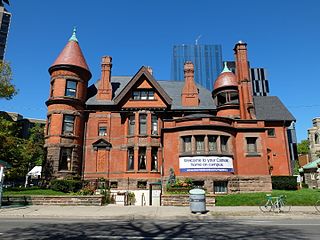
Newman Centre is the Roman Catholic university chaplaincy for the University of Toronto. It is housed in what was the home of Wilmot Deloui Matthews. It is located at the corner of Hoskin Avenue and St. George Street, across from the Robarts Library on the University of Toronto campus. It is under the direction of the Archdiocese of Toronto and is associated with the neighbouring St. John Henry Newman Catholic Church.
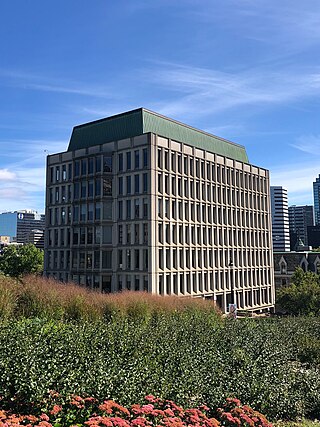
The Stephen Leacock Building, also known simply as the Leacock Building, is a building located at 855 Sherbrooke Street West, on the McGill University downtown campus in Montreal, Quebec. The building was named after Stephen Leacock, a well-known Canadian humorist and author, and Professor of Economics at McGill from 1901 to 1944. Built between 1962 and 1965 by the Montreal architectural firm Arcop, the Leacock Building's purpose was to accommodate the growing number of students at McGill, particularly in the Faculty of Arts which had outgrown its ancestral home, the Arts Building.
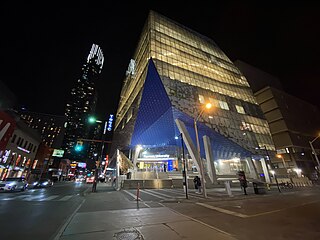
Toronto Metropolitan University (TMU), previously known as Ryerson University, opened a Student Learning Centre (SLC) located in downtown Toronto on the corner of Yonge Street and Gould Street in 2015.
